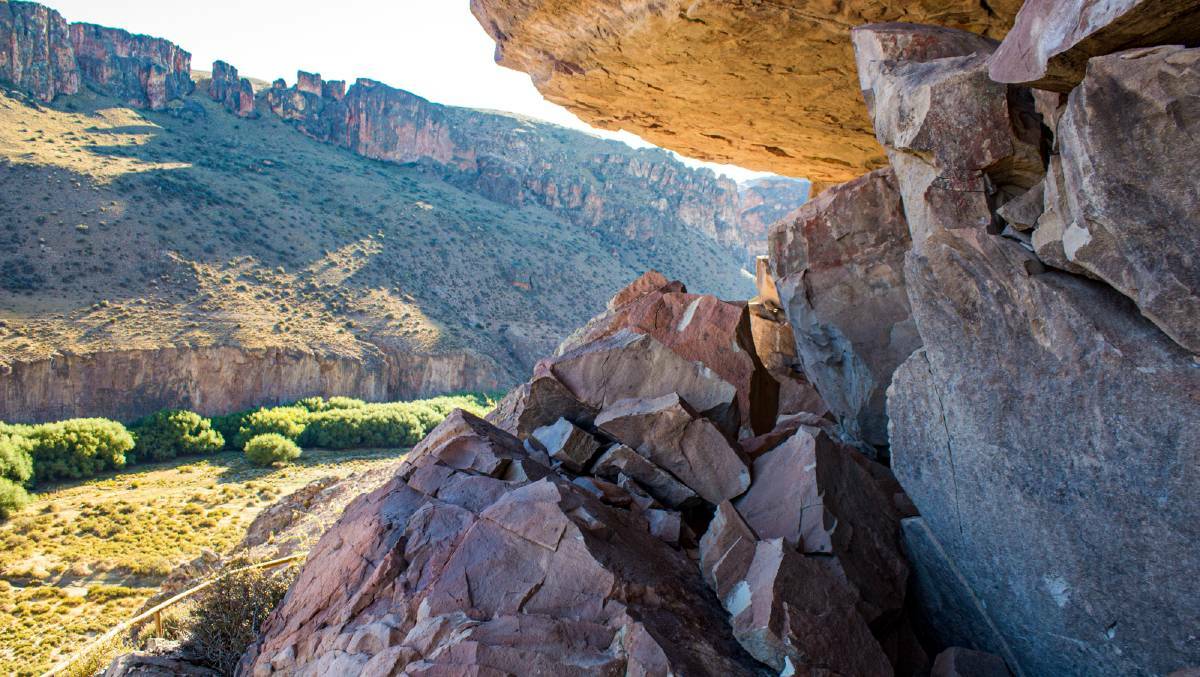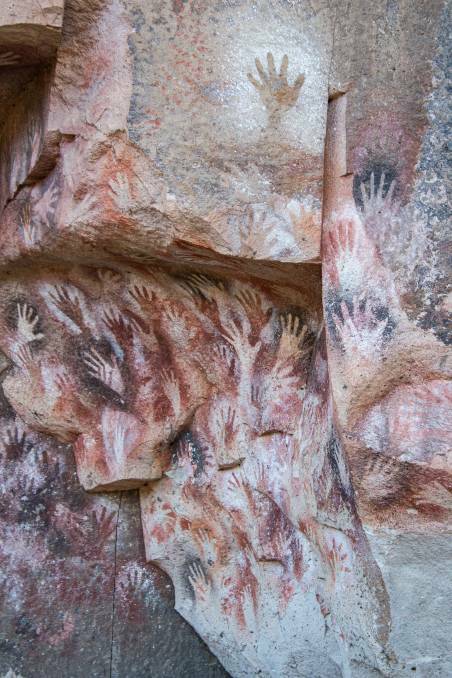This is the bit where everyone likes to take photos,” my guide tells me as she points to the handprints on the cave wall. “This is the most famous part.”
Create a free account to read this article
$0/
(min cost $0)
or signup to continue reading
In some ways, it is an unnecessary comment. The sudden splash of colour jumps out after my walk along a path high up one side of a ravine, with a dry riverbed at the bottom, jagged rock formations at the top, and a steep slope covered in tufts of brown grass in between.
But the guide is right. This is what I have come for: The Cave of Hands in the middle of remote Patagonian Argentina. (Although, technically, the site is probably best described as a series of rock overhangs or shelters, rather than a cave.)
Along the rockface, about halfway up the steep cliff, are hundreds of handprints. Orange, yellow, and red pigments sprayed onto the rock while hands were placed on its cold hard surface have left the impressions in negative of the fingers and palms. Long-forgotten humans reaching out from the past.
It’s been quite a journey for me to the Cave of Hands, which is nowhere near any other point of interest that a traveller would normally visit. I’m using public transport to move around Argentina and the only reason that I’m even able to do this is because the two-day bus trip I’m taking between cities in Patagonia has stopped near here overnight, offering an opportunity to do a quick tour at sunrise before the bus leaves again.

I’m the only person from the bus who has chosen to do the side trip so, aside from the local guide who waits here all day for visitors, it’s just me standing on the cliff with the caves along it. Silence fills the valley that stretches for kilometres in both directions.
It hasn’t always been this lonely, though. 9000 years ago, a whole community of primitive hunters would pass through this valley and stay among the rocks for shelter as they followed their prey across vast tracts of southern Argentina.
The hunters – men, women, and children – moved with the migration of the animals so their food source was always close. They would only attack the animals when they needed to eat, so there was a lot of time to rest. Some of these stops would have brought them to where I’m standing. They would’ve placed their palms on the rock and left these marks of their existence.

7000 years before the first book was created, and 4000 years before the Egyptians started writing their hieroglyphs on the walls, the hunters of Patagonia were documenting their stories in the art of these caves of hands.
Each print was a personal acknowledgement of their life, and each group of hands a demonstration of their community. Then, around these hands, they drew pictures of their daily activities that are a testament to their culture.
The main source of food was the guanaco, a llama-like animal in easy supply in this area. The drawings on the caves show the men hunting the creatures with primitive weapons but ingenious tactics. In one tableau, a crack in the rock is used to represent a ravine that the hunters would chase the animals into, making them easier to catch.
Their stories haven’t been lost. Their lives haven’t been forgotten.
There are lizards and spiders, pregnant animals and baby animals. There are even images of evil spirits in the drawings, representing their mythology, although we have no way to know the details of what their religion looked like. But whatever was important to these ancient people, the things that made their world what it was, are all depicted on the rock.
“What are those dots painted onto the roof of the cave?” I ask the guide.
“They could be the stars in the sky,” she says, “or maybe the marks of a game where the children would throw painted balls into the air.”
She chuckles. “We don’t really understand everything.”

There’s something nice about not knowing everything. There are enough clues here to give you a sense of the time, but the imagination is free to fill in some of the blanks.
I can picture the tribe sitting here, hunched around a fire, eating their guanaco, turning its skin into clothes, and painting the stories of the day on the walls around them.
I look at those pictures now and a scene comes to life, of men chasing the animals, shouting at each other to surround a herd, of proudly bringing their bounty back to their families.
I can even see an image of children throwing their painted balls at the roof of the cave, leaving little colourful dots that a traveller will marvel at 9000 years later.
Their stories haven’t been lost. Their lives haven’t been forgotten. Their paintings are more than just a diary for themselves because they have become a record of the time and a constant reminder of their existence. The ancient residents of Argentina’s Cave of Hands have become what every artist, writer, and even blogger dreams of being – narrators of history.




